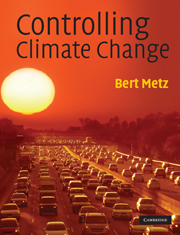Book contents
- Frontmatter
- Contents
- Preface
- 1 Climate change and its impacts: a short summary
- 2 Greenhouse gas emissions
- 3 Keeping climate change within sustainable limits: where to draw the line?
- 4 Development first
- 5 Energy Supply
- 6 Transportation
- 7 Buildings
- 8 Industry and waste management
- 9 Land use, agriculture, and forestry
- 10 How does it fit together?
- 11 Policies and measures
- 12 International climate change agreements
- Index
- Plate section
3 - Keeping climate change within sustainable limits: where to draw the line?
Published online by Cambridge University Press: 05 June 2012
- Frontmatter
- Contents
- Preface
- 1 Climate change and its impacts: a short summary
- 2 Greenhouse gas emissions
- 3 Keeping climate change within sustainable limits: where to draw the line?
- 4 Development first
- 5 Energy Supply
- 6 Transportation
- 7 Buildings
- 8 Industry and waste management
- 9 Land use, agriculture, and forestry
- 10 How does it fit together?
- 11 Policies and measures
- 12 International climate change agreements
- Index
- Plate section
Summary
What is covered in this chapter?
One of the big questions in controlling climate change is “how far do we go in limiting climate change?” The climate has already changed and greenhouse gases in the atmosphere today will lead to further change, even if emissions were completely stopped overnight. Emissions are increasing strongly. Social and technical change is slow, and so is political decision making. There are also costs to be incurred. So where to draw the line? This chapter will look at the normative clauses that are part of the Climate Convention, the role of science in decision making, and some of the political judgements that have been made. It will explore the emission reduction implications of stabilization of greenhouse gas concentrations in the atmosphere. It will investigate how such reductions can be realised. It will look into the role of adapting to a changed climate as part of the approach to manage the risk of climate change. Finally, costs of doing nothing will be compared to the costs of taking action.
What does the Climate Convention say about it?
The United Nations Framework Convention on Climate Change (to be referred to as UNFCCC or Climate Convention), signed at the 1992 Rio Summit on Environment and Development and effective since 1994, has an article that specifies the ‘ultimate objective’ of this agreement. It says:
The ultimate objective of this Convention and any related legal instruments that the Conference of the Parties may adopt is to achieve, in accordance with the relevant provisions of the Convention, stabilization of greenhouse gas concentrations in the atmosphere at a level that would prevent dangerous anthropogenic interference with the climate system.[…]
- Type
- Chapter
- Information
- Controlling Climate Change , pp. 51 - 77Publisher: Cambridge University PressPrint publication year: 2009



